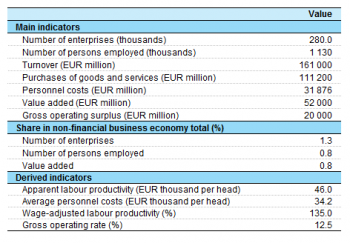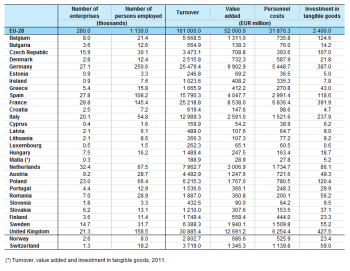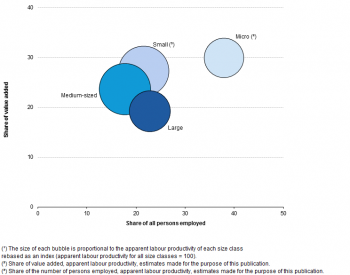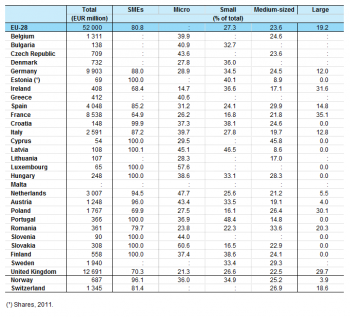Archive:Advertising and market research statistics - NACE Rev. 2
- Data from October 2015. Most recent data: Further Eurostat information, Main tables and Database.
This Statistics Explained article is outdated and has been archived - for recent articles on structural business statistics see here.
This article presents an overview of statistics for the advertising and market research sector in the European Union (EU), as covered by NACE Rev. 2 Division 73. It belongs to a set of statistical articles on 'Business economy by sector'.


(% share of sectoral total) - Source: Eurostat (sbs_na_1a_se_r2)





(% share of sectoral total) - Source: Eurostat (sbs_sc_1b_se_r2)


Main statistical findings
Structural profile
There were more than one quarter of a million enterprises (280 thousand) operating within the EU-28’s advertising and market research (Division 73) sector in 2012. These enterprises employed 1.1 million persons, which equated to 0. 8 % of the total number of persons employed in the non-financial business economy (Sections B to J and L to N and Division 95) and 9. 8 % of the total workforce for professional, scientific and technical activities (Section M).
In 2012, the value added for the EU-28’s advertising and market research sector reached EUR 52.0 billion, equivalent to 0.8 % of the non-financial business economy total and to 8. 7 % of the professional, scientific and technical activities total.
The apparent labour productivity apparent labour productivity of the EU-28’s advertising and market research sector in 2012 was EUR 46.0 thousand per person employed, below the professional, scientific and technical activities average of EUR 52.0 thousand per person employed and at a similar level to the non-financial business economy average of EUR 46.2 thousand per person employed. Average personnel costs within the EU-28’s advertising and market research sector were EUR 34.2 thousand per employee, which was much lower than the EUR 44.3 thousand per employee average for professional, scientific and technical activities, but somewhat higher than the EUR 32.4 thousand per employee average for the whole of the non-financial business economy. As a result of this mixed situation concerning labour productivity and personnel costs, the wage-adjusted labour productivity ratio for the EU-28’s advertising and market research sector in 2012 stood at 135. 0 %, somewhat higher than the professional, scientific and technical activities average of 118. 0 % but lower than the non-financial business economy average of 142.7 %.
The gross operating rate, which shows the relation between the gross operating surplus and turnover, is a measure of operating profitability. For the EU-28’s advertising and market research sector this rate was 12.5 % in 2012, somewhat higher than the non-financial business economy average (9. 4 %) but fairly lower than the professional, scientific and technical activities average (18. 3 %). As such, the advertising and market research sector recorded the third lowest gross operating rate among the seven NACE divisions within professional, scientific and technical activities, higher only than the gross operating rate that was recorded for scientific research and development (Division 72) and activities of head offices and management consultancy (Division 70).
Sectoral analysis
The EU-28’s advertising subsector (Group 73.1) dominated the advertising and market research sector and was more than 4.5 times as large as the market research and public opinion polling subsector (Group 73.2) in value added and employment terms — see Figure 1. The EU-28’s advertising subsector recorded a wage-adjusted labour productivity ratio of 136.0 % in 2012, below the non-financial business economy average of 142. 7 % but above the average of 118. 0 % for professional, scientific and technical activities. The wage-adjusted labour productivity ratio of the EU-28’s market research and public opinion polling subsector in 2012 was just slightly lower, at 130.0 %.
The gross operating rate for the EU-28’s advertising subsector was 12.0 % in 2012, somewhat higher than the non-financial business economy average (9. 4 %) and approximately two thirds of the professional, scientific and technical activities average (18. 3 %). For the EU-28’s market research and public opinion polling subsector, the gross operating rate (16.5 %) was higher and almost reached the professional, scientific and technical activities average in 2012 .
Country analysis
The United Kingdom recorded the highest level of value added (EUR 12.7 billion) among the EU Member States for the advertising and market research sector in 2012, which equated to a 24. 4 % share of the EU-28 total. Only Germany and France reported levels of value added within their respective advertising and market research sectors that were close to those in the United Kingdom (EUR 9.9 billion and EUR 8.5 billion); more than double the level recorded in Spain (EUR 4.0 billion). At a more detailed level, the United Kingdom was the leading Member State, in value added terms, in both advertising and market research subsectors — its share of EU-28 value added in the advertising subsector (Group 73.1) stood at 22. 7 %, and it was even higher in the market research and opinion polling subsector (Group 73.2), with a 32. 6 % share of EU-28 value added.
The United Kingdom was also the most specialised EU Member State in the advertising and market research sector, as 1. 2 % of the value added created in its non-financial business economy was generated by the advertising and market research sector in 2012. Other Member States that were relatively specialised in advertising and market research activities included Latvia (also 1. 2 % of non-financial business economy value added), Poland, the Netherlands, and France (all 1.0 %). The least specialised Member States were Hungary, Slovenia and Ireland where 0.5 % of non-financial business economy value added came from the advertising and market research sector in 2012, Italy (0.4 %), and Luxembourg, where the lowest share was reported (0. 3 %). Relatively low shares were also recorded for two of the non-member countries: the advertising and market research sector provided 0.5 % of non-financial business economy value added in Switzerland in 2012, a share that fell to 0.3 % in Norway.
The United Kingdom and Germany were the only EU Member States to report wage-adjusted labour productivity ratios for the advertising and market research sector (196.6 % and 161.3 %, respectively) that were above their national averages for the whole of the non-financial business economy in 2012; high wage-adjusted labour productivity ratios were recorded also in the advertising and market research sectors of Romania (167.5 %) and Estonia (164.6 %). At the other end of the scale, eleven EU Member States had the wage-adjusted labour productivity ratios of the advertising and market research sector between 100 % and 115 %; the lowest ratio was recorded in Slovenia (92.5 %) where it failed to pass parity as average personnel costs exceeded apparent labour productivity.
Most EU Member States reported a relatively low gross operating rate for advertising and market research in 2012. The largest player within this sector, the United Kingdom, recorded the highest profitability rate (according to this measure), at 20. 8 %, while the gross operating rate was also relatively high (in double-digits) for a number of the other Member States which had a considerable level of activity (Germany, the Netherlands and Poland); Estonia, Slovakia, Austria, Bulgaria and Belgium also recorded double-digit gross operating rates within their respective advertising and market research sectors. Both Norway and Switzerland reported their gross operating rates for the advertising and market research sector below 6 %.
Size class analysis
The relative importance of small and medium-sized enterprises (SMEs, employing fewer than 250 persons) within the EU-28’s advertising and market research sector was considerable, as they contributed 77. 2 % of the sectoral workforce and 80. 8 % of sectoral value added in 2012. There were 279.7 thousand SMEs within the EU-28’s advertising and market research sector, employing 872.1 thousand persons and generating EUR 42.0 billion of value added.
In employment terms, micro enterprises (employing fewer than 10 persons) accounted for the largest share of the EU-28’s workforce within the advertising and market research sector, with more than one third (37. 9 %) of the total, while they also recorded the highest share of value added (29. 9 %). The latter was only slightly higher than the share of sectoral value added accounted for by small enterprises (employing 10 to 49 persons), 27. 3 %. The high proportion of persons working in micro enterprises (compared with their share of value added) resulted in a relatively low apparent labour productivity ratio for micro enterprises within the EU-28’s advertising and market research sector (EUR 36.8 thousand per person employed in 2011); only slightly higher ratio (EUR 38.7 thousand in 2012) was reported for large enterprises (employing 250 or more persons). By contrast, small enterprises and medium-sized enterprises (employing 50 to 249 persons) had much higher apparent labour productivity rates, EUR 53.5 thousand per person employed (in 2011) and EUR 61.4 thousand per person employed (in 2012).
Given the relative importance of SMEs within the advertising and market research sector, it is perhaps not surprising to find that some of the EU Member States reported that the whole of their workforce in this activity was employed by their SME sector. Among those Member States for which data are available, this was the case for the Baltic Member States, Croatia, Cyprus, Finland, Hungary, Luxembourg, Portugal, Slovakia and Slovenia. The relative importance of large enterprises in terms of their contribution to employment opportunities within the advertising and market research sector rose to between 30.0 % and 40.0 % in the United Kingdom, France, and Germany; relatively high share was recorded also for Switzerland (28. 6 %). However, the relative importance of large enterprises peaked in Ireland, where large enterprises employed 43. 5 % of the advertising and market research workforce.
Data sources and availability
The analysis presented in this article is based on the main dataset for structural business statistics (SBS) and size class data, all of which are published annually.
The main series provides information for each EU Member State as well as a number of non-member countries at a detailed level according to the activity classification NACE. Data are available for a wide range of variables.
In structural business statistics, size classes are generally defined by the number of persons employed. A limited set of the standard structural business statistics variables (for example, the number of enterprises, turnover, persons employed and value added) are analysed by size class, mostly down to the three-digit (group) level of NACE. The main size classes used in this article for presenting the results are:
- small and medium-sized enterprises (SMEs): with 1 to 249 persons employed, further divided into;
- micro enterprises: with less than 10 persons employed;
- small enterprises: with 10 to 49 persons employed;
- medium-sized enterprises: with 50 to 249 persons employed;
- large enterprises: with 250 or more persons employed.
Context
This article presents an overview of statistics for the advertising and market research sector in the EU, as covered by NACE Rev. 2 Division 73.
Advertising agencies include the provision of a full range of advertising services including advice, creative services, production of advertising material and placement; some of these services may be subcontracted. Placement may be in newspapers, periodicals, radio, television, the internet and other media, as well as outdoor advertising, showroom design and aerial advertising. Services may also include the distribution or delivery of advertising material or samples, the creation of stands and other display structures, conducting marketing campaigns, and other advertising services aimed at attracting and retaining customers, for example, point-of-sale marketing and direct mail advertising.
Media representation services concern the sale or re-sale of time and space for various media soliciting advertising.
Market research includes investigation into market potential, awareness, acceptance and familiarity of goods and services and buying habits of consumers for the purpose of sales promotion and the development of new goods and services, including statistical analyses of the results. Public opinion polling is the investigation into collective opinions of the public about political, economic and social issues and statistical analysis thereof.
This NACE division is composed of two groups:
- advertising (Group 73.1);
- market research and public opinion polling (Group 73.2).
The information that is presented in this article does not cover the publishing of advertising material (included as part of publishing, Division 58), nor the production of commercial messages for radio, television and film (included within motion picture, video and television programme production, sound recording and music publishing activities, Division 59), nor advertising photography (included as part of other professional, scientific and technical activities, Division 74), nor convention and trade show organisers and mailing activities (which is classified as part of office administrative, office support and other business support activities, Division 82).
See also
- Other analyses of the business economy by NACE Rev. 2 sector
- Professional, scientific and technical activities
- Structural business statistics introduced
Further Eurostat information
Publications
- European business - facts and figures (online publication)
Main tables
Database
- SBS – services (serv)
- Annual detailed enterprise statistics for services (sbs_na_serv)
- Annual detailed enterprise statistics for services (NACE Rev. 2 H-N and S95) (sbs_na_1a_se_r2)
- SMEs - Annual enterprise statistics by size classes - services (sbs_sc_sc)
- Services by employment size classes (NACE Rev. 2 H-N and S95) (sbs_sc_1b_se_r2)
- Annual detailed enterprise statistics for services (sbs_na_serv)
- SBS - regional data - all activities (sbs_r)
- SBS data by NUTS 2 regions and NACE Rev. 2 (from 2008 onwards) (sbs_r_nuts06_r2)
Dedicated section
Source data for tables and figures (MS Excel)
Other information
- Decision 1578/2007/EC of 11 December 2007 on the Community Statistical Programme 2008 to 2012
- Regulation (EC) No 295/2008 of 11 March 2008 concerning structural business statistics